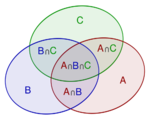Difference between revisions of "AP Statistics Curriculum 2007 Prob Rules"
(→Example - Monty Hall Problem) |
(→Example) |
||
| Line 20: | Line 20: | ||
:<math>P(A | B) ={P(A \cap B) \over P(B)}.</math> | :<math>P(A | B) ={P(A \cap B) \over P(B)}.</math> | ||
| − | ===Example=== | + | ===Example - contingency table=== |
Here is the data on 400 Melanoma (skin cancer) Patients by Type and Site | Here is the data on 400 Melanoma (skin cancer) Patients by Type and Site | ||
<center> | <center> | ||
Revision as of 00:01, 29 January 2008
General Advance-Placement (AP) Statistics Curriculum - Probability Theory Rules
Addition Rule
The probability of a union, also called the Inclusion-Exclusion principle allows us to compute probabilities of composite events represented as unions (i.e., sums) of simpler events.
For events A1, ..., An in a probability space (S,P), the probability of the union for n=2 is \[P(A_1\cup A_2)=P(A_1)+P(A_2)-P(A_1\cap A_2),\]
For n=3, \[P(A_1\cup A_2\cup A_3)=P(A_1)+P(A_2)+P(A_3) -P(A_1\cap A_2)-P(A_1\cap A_3)-P(A_2\cap A_3)+P(A_1\cap A_2\cap A_3)\]
In general, for any n, \[P(\bigcup_{i=1}^n A_i) =\sum_{i=1}^n P(A_i) -\sum_{i,j\,:\,i<j}P(A_i\cap A_j) +\sum_{i,j,k\,:\,i<j<k}P(A_i\cap A_j\cap A_k)+ \cdots\cdots\ +(-1)^{j+1} P(\bigcap_{i=1}^j A_i)+ \cdots\cdots\ +(-1)^{n+1} P(\bigcap_{i=1}^n A_i).\]
Conditional Probability
The conditional probability of A occurring given that B occurs is given by \[P(A | B) ={P(A \cap B) \over P(B)}.\]
Example - contingency table
Here is the data on 400 Melanoma (skin cancer) Patients by Type and Site
| Site | ||||
| Type | Head and Neck | Trunk | Extremities | Totals |
| Hutchinson's melanomic freckle | 22 | 2 | 10 | 34 |
| Superficial | 16 | 54 | 115 | 185 |
| Nodular | 19 | 33 | 73 | 125 |
| Indeterminant | 11 | 17 | 28 | 56 |
| Column Totals | 68 | 106 | 226 | 400 |
- Suppose we select one out of the 400 patients in the study and we want to find the probability that the cancer is on the extremities given that it is of type nodular: P = 73/125 = P(Extremities | Nodular)
- What is the probability that for a randomly chosen patient the cancer type is Superficial given that it appears on the Trunk?
Example - Monty Hall Problem
Recall that earlier we discussed the Monty Hall Experiment. We will now show why the odds of winning double if we use the swap strategy - that is the probability of a win is 2/3, if each time we switch and choose the last third card.
Denote W={Final Win of the Car Price}. Let L1 and W2 represent the events of choosing the donkey (loosing) and the car (winning) at the player's first and second choice, respectively. Then, the chance of winning in the swapping-strategy case is\[P(W) = P(L_1 \cap W_2) = P(W_2 | L_1) P(L_1) = 1 \times {2\over 3} ={2\over 3}\]. If we played using the stay-home strategy, our chance of winning would have been\[P(W) = P(W_1 \cap W_2) = P(W_2 | W_1) P(W_1) = 1 \times {1\over 3} ={1\over 3}\], or half the chance in the first (swapping) case.
Multiplication Rule
Model Validation
Checking/affirming underlying assumptions.
- TBD
Computational Resources: Internet-based SOCR Tools
- TBD
Examples
Computer simulations and real observed data.
- TBD
Hands-on activities
Step-by-step practice problems.
- TBD
References
- TBD
- SOCR Home page: http://www.socr.ucla.edu
Translate this page:
